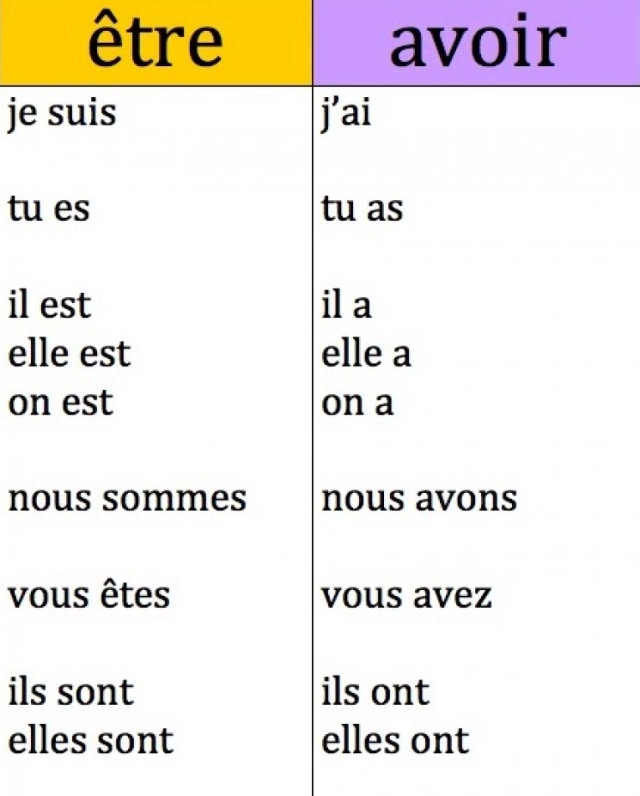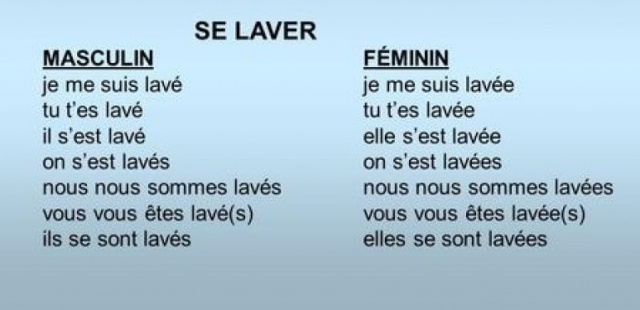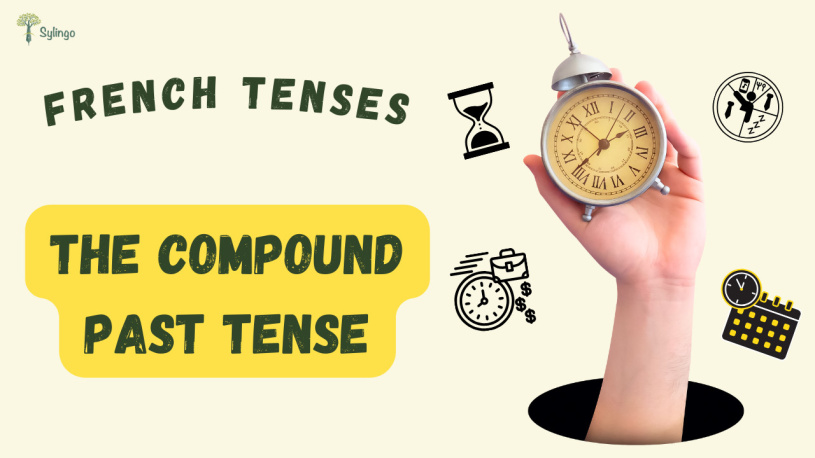"Le passé composé" is the compound past tense in French. It's used to express actions that occurred in the past and are considered completed. It is one of the most frequently used past tenses in daily life, both in writing and speaking. In this lesson, we will learn about the compound past and how to conjugate it, as well as when to use it.
When do we use passé composé (the compound past)?
We use passé composé to express events that occurred in the recent past.
How to form passé composé:
The verb "être" or "avoir" in the present tense + the past participle of the verb we want to conjugate (Le participe passé).

Note: "être" and "avoir" are used as auxiliary verbs.
How do we determine whether to use "être" or "avoir"?
1- There are fourteen verbs that use "être" in passé composé.
These verbs are part of the first group of verbs that use "être" as the auxiliary verb when forming the passé composé. They often involve movement or changes in location.
| Sortir | To go out | Entrer | To enter |
| Descendre | To descend | Monter | To go up |
| Partir | To depart | Rester | To stay |
| Tomber | To fall | Passer | To pass |
| Retourner | To return | Aller | To go |
| Naître | To be born | Mourir | To die |
| Revenir | To come back | Arriver | To arrive |
When using passé composé with these verbs, you would say, for examples:
| Il est sorti. | He went out. |
| Elle est descendue. | She went down. |
| Ils sont arrivés. | They arrived. |
2- Reflexive verbs "Les verbes pronominaux":
"Les verbes pronominaux" are reflexive verbs in French. They are called so because they include reflexive pronouns such as "me," "te," "se," "nous," "vous," "se," which indicate that the subject of the verb is also the object, reflecting the action back onto the subject.
These verbs are commonly used to describe actions that someone does to themselves. For example:
| se reposer | to rest |
| se promener | to take a walk |
| se lever | to get up |
| se laver | to wash oneself |
| s'amuser | to have fun |
| s'arrêter | to stop |
| se réveiller |
to wake up |
| se coucher | to go to bed |
Reflexive pronouns:
| je | me |
| tu | te |
| il \ elle | se |
| nous | nous |
| vous | vous |
| ils \ elles | se |
| s'appelle | se lever |
|
| je | m'appelle | me lève |
| tu | t'appelles | te lèves |
| il \ elle | s'appelle | se lève |
| nous | nous appelons | nous levons |
| vous | vous appelez | vous levez |
| ils \ elles | s'appellent | se lèvent |
Examples:
| Je me lave. | I wash myself. |
| Tu te promènes. | You take a walk. |
| Elle se réveille. | She wakes up. |
| Je me repose. |
I rest myself. / I rest. |
| Il se lave. | He washes himself. |
| Nous nous promenons. |
We walk ourselves. / We take a walk. |
| Il se promène. | He takes a walk. |
Uses of Reflexive Verbs:
Reflexive verbs express three things: (Reflexion - Reciprocity - Passive Voice)
1- Reflexion:
This means that the verb is performed by the subject on itself, not on another person.And these verbs are commonly used to describe actions that someone does to themselves.
Examples:
What's the difference between "se laver" and "laver"?
se laver - to wash oneself
Je me lave - I wash myself
laver - to wash
Je lave la vaisselle - I wash the dishes
Here, the verb "laver" is non-reflexive, meaning it's done to the dishes, not to oneself.
What's the difference between "se lever" and "lever"?
se lever - to get up
Je me lève à 7h - I get up at 7 o'clock
lever - to wake someone else up
la mère lève sa fille à 8h - The mother wakes her daughter up at 8 o'clock.
2- Reciprocity:
They can also be used for reciprocal actions between two or more people, where each person performs the action on the other. For examples:
| Ils se parlent. | They talk to each other. |
| Mary et Pierre s’aiment. | Marie and Pierre love each other. |
| Les frères s’aident. | Siblings help each other. |
3- Passive Voice:
In the passive voice, the verb indicates that the subject is being acted upon.
Examples:
| Ses livres se vendent dans cette librairie. | Books are sold in this bookstore. |
| Le thé se boit chaud. | Tea is drunk hot. |
Note:
The past participle used with the auxiliary verb "être" agrees in gender and number with the subject:
If the subject is singular and feminine, add an "e" to the past participle.
If the subject is plural and masculine, add an "s," to the past participle.
If it's plural and feminine, add "es" to the past participle.

Next, we will learn the past participle of verbs according to the three groups:
First: Past Participle in the First Group, which includes verbs ending in "er":
In this case, you remove "er" and add "é" in its place. For example:
manger - to eat becomes "mangé" (eaten).
chanter - to sing becomes "chanté" (sung).
étudier - to study becomes "étudié" (studied).
Second: Past Participle in the Second Group, which includes verbs ending in "ir":
Here, you remove "ir" and add "i" in its place. For example:
finir - to finish becomes "fini" (finished).
réfléchir - to think becomes "réfléchi" (thought).
Third: Past Participle in the Third Group, which includes verbs ending in "ir", "oir", or "re":
These verbs don't have a general rule for forming past participles. It depends on the verb.
1- For verbs ending in "ir", you remove "ir" and add "u" or "t" in its place. For example:
For verbs ending in "u":
| Infinitive Verb | Past Participle | |
| courir | couru | to run |
| venir | venu | to come |
| tenir | tenu | to hold |
For verbs ending in "t":
| Infinitive Verb | Past Participle | |
| couvrir | couvert | to cover |
| mourir | mort | to die |
| offrir | offert | to offer |
| ouvrir | ouvert | to open |
| souffrir | souffert | to suffer |
2- Verbs ending in "re" do not follow a specific rule for past participles, and each verb should be learned individually.
| Infinitive Verb | Past Participle | |
| attendre | attendu | to wait |
| entendre | entendu | to hear |
| répondre | répondu | to answer or respond |
| descendre | descendu | to descend or go down |
| vendre | vendu | to sell |
| perdre | perdu | to lose |
| connaître | connu | to know or be acquainted with |
| apparaître | apparu | to appear |
These are irregular verbs that end in "-re" in French and do not follow a specific pattern for forming the past participle:
| Infinitive Verb | Past Participle | |
| naître | né | to be born |
| suivre | suivi | to follow |
| boire | bu | to drink |
| vivre | vécu | to live |
| lire | lu | to read |
| décrire | décrit | to describe |
| écrire | écrit | to write |
| dire | dit | to say |
| faire | fait | to do or make |
| être | été | to be |
These verbs are irregular and have unique past participle forms that do not follow the regular conjugation patterns. You need to memorize these forms for each verb individually.
3- Verbs ending in "-oir" typically follow a pattern when forming their past participles:
You remove the "-oir" ending and replace it with "-u" to form the past participle. Here are some examples:
| Infinitive Verb | Past Participle | |
| falloir | né | to be necessary |
| pleuvoir | plu | to rain |
| recevoir | reçu | to receive |
| vouloir | voulu | to want |
| pouvoir | pu | to be able to |
| devoir | dû | to have to, must |
| savoir | su | to know |
| voir | vu | to see |
| avoir | eu | to have |
These verbs are essential in French, and understanding their past participle forms is important for conjugation.
The negative:
In negating a compound past action in French, you place the negation words around the auxiliary verb alone. This means that when forming a negative sentence in the compound past tense (passé composé), the negation words go before and after the auxiliary verb, not the past participle. Here's how it works:
1- First, you have the negation words "ne" and "pas" that surround the helping verb.
2- Then, you place the helping verb, which is usually "avoir" or "être," between these negation words.
3- Finally, the past participle of the main verb is placed at the end of the sentence.
For example:
In a sentence like "I did not eat" (Je n'ai pas mangé), you would have:
"ne" before the helping verb "ai."
The helping verb "ai" (from "avoir") in the middle.
"pas" after the helping verb.
The past participle "mangé" at the end.
So, the structure is: "ne + helping verb + pas + past participle."
|
To work - travailler |
||||
| travaillé | pas | ai | ne | je |
| travaillé | pas | as | ne | tu |
| travaillé | pas | a | ne | il / elle |
| travaillé | pas |
avons |
ne | nous |
| travaillé | pas |
avez |
ne | vous |
| travaillé | pas |
ont |
ne | ils / elles |
Example:
Affirmative: Il est venu. (He came.)
Negative: Il n'est pas venu. (He did not come.)
In this case, "est" is the auxiliary verb, and the negation words "ne" and "pas" surround this auxiliary verb.
This structure is used to form negative sentences in compound past tense in French.
In negative sentences in compound past tense (passé composé) with reflexive verbs (les verbes pronominaux), the reflexive pronoun (me, te, se, nous, vous, se) is placed before the helping verb (usually "avoir" or "être") and between the negation words "ne" and "pas." Here's how it works:
1- First, you have the negation words "ne" and "pas" that surround the reflexive pronoun and the helping verb.
2- Then, you place the reflexive pronoun (me, te, se, nous, vous, se) just before the helping verb.
3- The helping verb comes next.
4- Finally, the past participle of the main verb is placed at the end of the sentence.
For example, in a sentence like "I did not wake up" (Je ne me suis pas réveillé(e)), you would have:
"ne" before the reflexive pronoun "me."
The reflexive pronoun "me."
The helping verb "suis" (from "être") following the reflexive pronoun.
"pas" after the helping verb.
The past participle "réveillé(e)" at the end.
So, the structure is: "ne + reflexive pronoun + helping verb + pas + past participle."
|
To wash oneself - se laver |
||||
| lavé | pas | me suis | ne | je |
| lavé | pas | t’es | ne | tu |
| lavé - lavée | pas | s’est | ne | il / elle |
| lavés | pas |
nous sommes |
ne | nous |
| lavés | pas |
vous êtes |
ne | vous |
| lavés - lavées | pas |
se sont |
ne | ils / elles |
This structure is used to form negative sentences with reflexive verbs in the compound past tense in French.
Here's a list of some common past participles for important French verbs:
You can add them to your Sylingo account, save them, and practice with them through tests.
| le verbe | Le participe passé |
|---|---|
| avoir | eu |
| voir | vu |
| savoir | su |
| devoir | dû |
| pouvoir | pu |
| vouloir | voulu |
| recevoir | reçu |
| pleuvoir | plu |
| falloir | fallu |
| être | été |
| faire | fait |
| dire | dit |
| écrire | écrit |
| décrire | décrit |
| lire | lu |
| vivre | vécu |
| boire | bu |
| suivre | suivi |
| naître | né |
| apparaître | apparu |
| connaître | connu |
| perdre | perdu |
| vendre | vendu |
| descendu | descendre |
| répondu | répondre |
| entendu | entendre |
| attendre | attendu |
| souffrir | souffert |
| ouvrir | ouvert |
| offrir | offert |
| mourir | mort |
| couvrir | couvert |
| tenir | tenu |
| venir | venu |
| courir | couru |
| réfléchir | réfléchi |
| finir | fini |
| étudier | étudié |
| chanter | chanté |
| manger | mangé |
| aller | allé |
| partir | parti |
| retourner | retourné |
| descendre | descendu |
| monter | monté |
| tomber | tombé |
| entre | entré |
| arriver | arrivé |
| sortir | sort |
| rester | resté |
I hope this helps you understand how to form past participles for different verb groups in French!
Here, we've learned about the compound past tense and its formulation. If you have any questions or inquiries, feel free to write them in the comments, and I'll be happy to respond.






